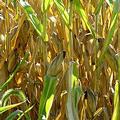 據「憂思科學家聯盟」(UCS)最新一份報告指出,黃豆及玉米在改造基因成耐除草劑的特性後,在美國境內種植後的結果發現其產量並未如預期般增加;而改良後的抗蟲性玉米的產量充其量只能算是少量提升。
據「憂思科學家聯盟」(UCS)最新一份報告指出,黃豆及玉米在改造基因成耐除草劑的特性後,在美國境內種植後的結果發現其產量並未如預期般增加;而改良後的抗蟲性玉米的產量充其量只能算是少量提升。
該研究發現,過去13年來種植作物產量之所以增加,主要還是歸功於傳統的繁殖方式或是農業技術的進步。
UCS糧食與環境計劃著名生物學家同時也是此次研究報告主筆的謝爾曼(Doug Gurian-Sherman)博士表示,生技產業在研究與宣傳方面已花費數十億美元之多,不過得到的基因改造的食物與飼料卻沒有辦法讓美國農民在每畝地上,收割出如同宣傳所說那般高報酬率。相形之下,依傳統的繁殖法則耕種的產量卻不斷繼續增加。
當時糧食價格翻高且全球糧食需求量拉起警報,於是人們冀望可以找到什麼方法,提高農作物的產量。各大生技公司看準良機,大肆宣傳基改作物就是未來達成這個目標的他山之石,於是人們開始對基改作物產生期待。
舉例來說,全球最大種子生產商孟山都(Monsanto)公司日前正如火如荼地推出宣傳廣告,當中透露著全球總人口數瀕臨爆炸,唯有高級的種苗……才得大幅提高作物的產量。
UCS對於外界對基改作物有助提高生產量的說法提出辯駁,認為在未來幾年內,基因改造很難在提升糧食生產量上扮演重要的角色。
不過許多美國務農者儘管使用各式基因改造作物,並未對實際的收穫結果怨聲載道。像是美國印第安那州農民便廣泛地接受基改的種子。2008年的農事時節裡,該州96%的黃豆及78%的玉米種植面積,土裡埋的種子或多或少都有基改後的特性。換算起來,等同超過9,600萬畝的耕地是種植基改的玉米和黃豆。
參與美國普渡大學農業推廣計劃的昆蟲學家歐伯麥爾(John Obermeyer),見證了生技作物在對抗玉米最大害蟲上所表現出的成果,而這些害蟲主要是歐洲玉米螟蟲和會蠶食玉米根的昆蟲。生技作物可以有效地完全抗拒螟蟲的侵害,而這些害蟲也還無法克服這些具抗蟲性的基改玉米。
最近的研究發現,對於發展中區域如非洲的南薩哈拉地區的貧困農民來說,使用有機與類似耕作方式,不但可以減少對農藥與合成肥料的依賴,還能讓作物產量增加,其結果是縮短成本卻增加收入。
UCS的報告最後鼓勵美國農業部、各州農業局以各級大學加強研發可以有效提高作物生產量的方式,例如揉合傳統與現代的繁種技術、永續及有機耕作,以及其他成熟的農耕技術,讓農民可以減輕肩頭上沉重的成本負擔。
不但如此,該報告也建議美國糧食援助組織應讓上述之方法,在偏遠的發展中國家內,同樣運行的起來。
Genetically engineering herbicide-tolerant soybeans and herbicide-tolerant corn has not increased yields in the United States, while insect-resistant corn has improved yields only marginally, new research by the Union of Concerned Scientists concludes.
The increase in yields for both crops over the last 13 years, the report found, was largely due to traditional breeding or improvements in agricultural practices.
"The biotech industry has spent billions on research and public relations hype, but genetically engineered food and feed crops haven't enabled American farmers to grow significantly more crops per acre of land," said Doug Gurian-Sherman, a biologist in the UCS' Food and Environment Program and author of the report. "In comparison, traditional breeding continues to deliver better results."
It comes at a time when food price spikes and localized shortages worldwide have prompted calls to boost agricultural productivity. Biotechnology companies claim that genetic engineering is essential to meeting this goal.
Monsanto, for example, is currently running an advertising campaign warning of an exploding world population and claiming that its "advanced seeds ... significantly increase crop yields."
The UCS report disputes that claim, concluding that genetic engineering is unlikely to play a significant role in increasing food production in the foreseeable future.
But the many U.S. growers who use genetically engineered varieties are not complaining. Indiana producers have accepted biotech seed en masse. During the 2008 crop season, 96 percent of the soybean and 78 percent of the corn acres in Indiana were planted with hybrids containing one or more biotech traits. That equals more than 9.6 million acres of corn and soybeans.
Purdue Extension entomologist John Obermeyer has witnessed the advent of biotech traits designed to resist damage done to corn by European corn borer and corn rootworm: the two most devastating corn pests. The Bt genes to control corn borer have been 100 percent effective, and the insect has not developed resistance to the genetically modified Bt corn.
Recent studies have shown that organic and similar farming methods that minimize the use of pesticides and synthetic fertilizers can more than double crop yields at little cost to poor farmers in such developing regions as Sub-Saharan Africa.
The report recommends that the U.S. Department of Agriculture, state agricultural agencies, and universities increase research and development for proven approaches to boost crop yields, such as modern conventional plant breeding methods, sustainable and organic farming, and other sophisticated farming practices that do not require farmers to pay significant upfront costs.
The report also recommends that U.S. food aid organizations make these more promising and affordable alternatives available to farmers in developing countries.




